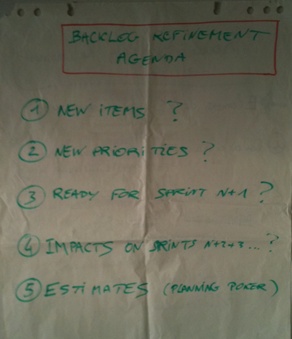Personas Method and Agile
Posted by jc-Qualitystreet on 2018/02/10
Here a short presentation I gave recently (in french) that will make happy Agile UX practitionners.
Agile Coaching, Product and User Experience, Agile & Lean Management
Saturday, April 27, 2024
Subscribe to the RSS Feed
Posted by jc-Qualitystreet on 2018/02/10
Here a short presentation I gave recently (in french) that will make happy Agile UX practitionners.
Posted by jc-Qualitystreet on 2013/07/30
Changing the culture of an organization is a complex and multifaceted operation that requires a lot of effort: this is why I like the word « transformation » . This transformation can obviously be undertaken from various angles … hacking is one of them.
Hacking is a viral and very relevant approach when it comes to change and improve cultural elements of everyday working-life, like meetings…
Meeting is a strong symbol in organizational culture… and meetings, often seen as waste of time, can be hacked!
Here are the 8 hacks…
Posted by jc-Qualitystreet on 2013/03/18
Inspired by classic coaching tools (like the wheel of life), this wheel of Agile Management helps me in my coaching activities with Managers involved in Agile transformation. The tool is visual and efficient, useful to explore current situation or to prepare coaching.
Thank you to @bangalaurent helping me to formalize it!
Obviously, the wheel is not fixed and can be contextualized …
For details of each category, take a look at this article : Manager 3.0 Being an Agile Manager
This is a self-assessment tool …
Posted by jc-Qualitystreet on 2012/05/26
Here are the slides of the presentation I gave at Agile France 2012 (Paris)
Posted by jc-Qualitystreet on 2012/03/01
The art of the specification in a agile context is above all collaborative. It’s also a matter of behavior.
As you know I like user stories. The format is a good way to express a requirement and to initiate the conversation between a Product Owner (supported or not by UX specialist, Business Analyst…) and the Team.
But of course, this short description, usually in one or two lines, is not sufficient to enable a Team to develop the functionality described… (see agile PROTOTYPING)
In short, the idea behind this precious checklist (inspired by Lisa Crispin and Janet Gregory‘s book) is to facilitate the job of the Product Owner.
With this checklist, the Product Owner identifies the key elements that must come (in his context) with a specific User story. For example, these important test cases must be envisioned or a link to UX stuff, wireframe of the screen, UI library or a prototype must be provided.
This is also the place where you can start describing required business rules (the business rules paragraph was crucial for financial and supply chain projects I was involved in and we linked it to an ATDD approach).
The Product Backlog Refinement (the » forgotten » 5th Scrum ceremonial for grooming activities 🙂 ) or other dedicated collaborative workshops are good opportunities to work on the checklist and to make sure that a specific user story will be ready to be taken and developed during the next sprint.

Product Backlog Refinement Agenda
Then, several days later, first day of the new sprint, the sprint planning part I (scope definition) will be used to confirm the various elements, especially the conditions of satisfaction, and the engagement of the Team to develop, by the end of the sprint, the user stories discussed.
Remember: feedback and collaboration!